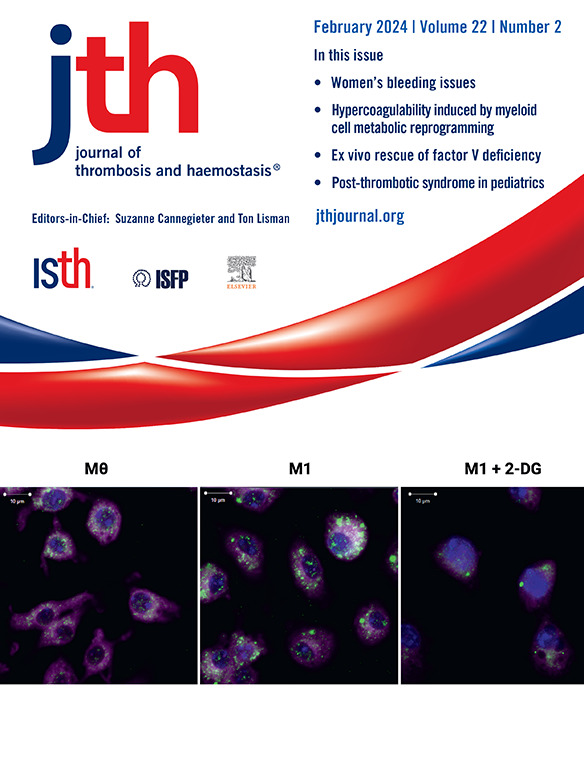Description of the clinical and radiological characteristics of pulmonary embolism in COVID-19 vs non–COVID-19 patients: a multicentric cross-sectional study over a 24-month perspective
IF 5.5
2区 医学
Q1 HEMATOLOGY
引用次数: 0
Abstract
Background
COVID-19 is associated with intense systemic inflammation and abnormal coagulation profile, leading to an increased incidence of pulmonary embolism (PE).
Objectives
This study investigates whether PE in COVID-19 patients has different clinical, laboratory, and radiological characteristics compared with traditional PE in COVID-19–negative patients.
Methods
We conducted an observational, multicentric, cross-sectional study on consecutive patients diagnosed with PE at admission or during hospital stay from February 21, 2019, to February 20, 2021. We compared clinical and laboratory data and computed tomography images between COVID-19–positive and COVID-19–negative patients. The extent of PE was evaluated using the Qanadli Index.
Results
Among 771 enrolled patients with acute PE, 89 were COVID-19–positive. COVID-19 patients were predominantly male (59.6% vs 41.5%, P = .001) and exhibited fewer classic venous thromboembolism (VTE) risk factors, such as previous VTE (3.5% vs 11.5%, P = .02) and active cancer (4.7% vs 24.2%, P < .0001). Additionally, these patients showed lower median troponin T and pro-B-type-natriuretic-peptide levels (10 vs 32 ng/L, P = .0002; and 383 vs 1448 pg/mL, P = .004, respectively), a lower median Qanadli Index (4 vs 7, P = .0013), more distal PE obstructions (53.5% vs 32.9%, P < .001), and less frequent right ventricular dilatation (4.1% vs 10.9%, P = .09).
Conclusion
In COVID-19 patients, traditional VTE risk factors were less frequent, a possible role for in situ thrombo-inflammatory processes. The reduced radiological extent and severity of PE observed in COVID-19 patients may reflect an in situ thrombo-inflammatory process rather than classical embolization; however, this hypothesis needs to be confirmed by other studies.
COVID-19患者与非COVID-19患者肺栓塞的临床和影像学特征描述:一项为期24个月的多中心横断面研究
背景:COVID-19与强烈的全身性炎症和凝血异常相关,导致肺栓塞(PE)的发生率增加。本研究探讨COVID-19患者的PE与传统的COVID-19阴性患者的PE相比是否具有不同的临床、实验室和影像学特征。方法:我们对2019年2月21日至2021年2月20日入院或住院期间诊断为PE的连续患者进行了一项观察性、多中心、横断面研究。我们比较了COVID-19阳性和阴性患者的临床、实验室资料和计算机断层扫描(CT)图像。采用Qanadli指数评价PE程度。结果:771例急性PE患者中,89例COVID-19阳性。COVID-19患者以男性为主(59.6%比41.5%;p=0.001),表现出较少的典型静脉血栓栓塞危险因素,如既往静脉血栓栓塞(3.5% vs. 11.5%;P =0.02)和活动性癌症(4.7% vs. 24.2%;结论:在COVID-19患者中,传统的静脉血栓栓塞危险因素较少,可能与原位血栓炎症过程有关。在COVID-19患者中观察到的PE的放射学程度和严重程度降低可能反映了原位血栓炎症过程,而不是传统的栓塞;然而,这一假设需要其他研究来证实。
本文章由计算机程序翻译,如有差异,请以英文原文为准。
求助全文
约1分钟内获得全文
求助全文
来源期刊
CiteScore
24.30
自引率
3.80%
发文量
321
审稿时长
1 months
期刊介绍:
The Journal of Thrombosis and Haemostasis (JTH) serves as the official journal of the International Society on Thrombosis and Haemostasis. It is dedicated to advancing science related to thrombosis, bleeding disorders, and vascular biology through the dissemination and exchange of information and ideas within the global research community.
Types of Publications:
The journal publishes a variety of content, including:
Original research reports
State-of-the-art reviews
Brief reports
Case reports
Invited commentaries on publications in the Journal
Forum articles
Correspondence
Announcements
Scope of Contributions:
Editors invite contributions from both fundamental and clinical domains. These include:
Basic manuscripts on blood coagulation and fibrinolysis
Studies on proteins and reactions related to thrombosis and haemostasis
Research on blood platelets and their interactions with other biological systems, such as the vessel wall, blood cells, and invading organisms
Clinical manuscripts covering various topics including venous thrombosis, arterial disease, hemophilia, bleeding disorders, and platelet diseases
Clinical manuscripts may encompass etiology, diagnostics, prognosis, prevention, and treatment strategies.

 求助内容:
求助内容: 应助结果提醒方式:
应助结果提醒方式:


